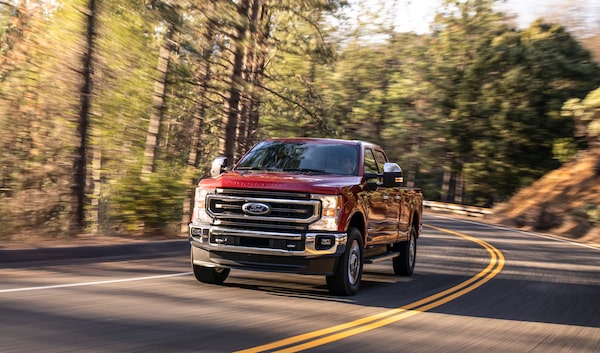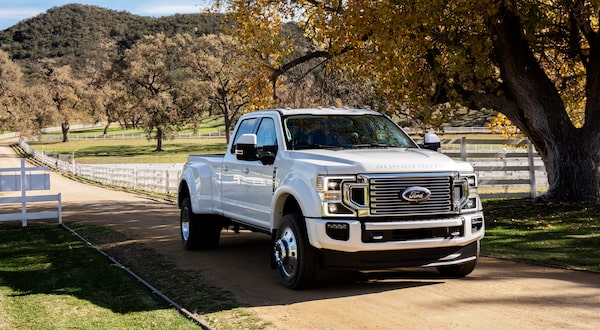
The Ford F-250s with the 6.2 gas engine have a six-speed.Courtesy of manufacturer
Wheeling west out of Phoenix, the F-350 I’m driving triggers a distant memory. Some 25 years ago, I overheard heard some guy announce he’d just bought himself a Ford F-350 pickup. “What do you need that for?” his companion asked. “Don’t need it,” responded the first guy. “I just like the look of myself in it.”
Then as now, the notion of a gas-guzzling monster truck as fashion accessory or ego inflator is utterly alien to my own eco-weenie values. And yet.
At a certain level, I get it. There is something seductive about sitting high and mighty on a throne-like seat within the cab of a truck that looms over every other light-duty vehicle on the road. Especially when the truck is so much better to drive than should be possible for anything so huge, heavy and capable.
Still, Detroit doesn’t build trucks like these for posing or for driving pleasure. As Dave Cotton, Ford Canada’s vehicle line specialist for pickup trucks, puts it, “The [mid-size] Ranger is purchased for recreation; the [full-size] F-150 is for a mix of recreation and work; and the Super Duty is for work. Typically, Super Duty trucks are towing something almost every day.”
While GM and Ram introduced all-new HDs in the last year, the 2020 Super Duty is more a major refresh of the aluminum-bodied generation that was all new in 2017. Aside from cosmetic alterations inside and out, the key upgrades are two new engine options, and an available 10-speed transmission.
Last year in Canada Ford sold 145,000 F-Series, making it the top-selling pickup in Canada for the 54th year running. Up to a quarter of those were the Super Duty, as Ford brands its F-250-and-up Heavy Duty offerings. Truck size classifications are confusing (and go as high as F-750 in Ford’s case), so let’s just say unless you’re a fleet manager for a national construction or oil-and-gas corporation, your HD pickup needs will be covered by an F-250 or F-350 (or the opposition’s 2500 or 3500 trucks) or in Ford’s case perhaps an F-450.

The F-450 offers as a full-bodied pickup, whereas GM and Ram 4500s are chassis-cab only.Courtesy of manufacturer
Perhaps you run a small landscaping business, or your leisure activities involve a big boat, RV or multihorse trailer. Or yes, maybe you’re just a fashionista poseur.
Ford’s F-450 gets a mentioned because it’s offered as a full-bodied pickup, whereas GM and Ram 4500s are chassis-cab only. It’s also an F-450 duallie that enables Ford’s new record tow rating of up to 37,000 pounds. However, suitably specced F-350s aren’t far behind at up to 35,750 pounds, which is also in the ball-park with rival 3500s.
On select models suitably equipped, Ford claims a bewildering array of 21 overall or category industry-best payloads and tow ratings. The F-350’s record 7,850-lb payload means it can carry its own weight. But as usual in this game of bragging rights, the highest ratings are for very specific models. For most combos of cab, wheelbase, drivetrain, engine, axle and rear-wheel count, tow ratings range between 12,000 and 23,000 lbs.
All new for 2020 is a 7.3-litre OHV gas V-8 rated at 430 horsepower and 475 lb-ft. Unrelated to the carryover 6.2-litre OHC gas V-8, the 7.3 was developed from scratch for use in the bigger Medium-Duty trucks, so its availability on the lighter Super Duty trucks is like a bonus.
The diesel is a third-generation upgrade of the 6.7-litre Power Stroke V-8, with outputs bumped to 475 hp and a titanic 1,050 lb-ft of torque. Ford was peeved when Ram claimed the 1,000-lb-ft threshold first, but then went beyond it – and unlike on Ram it’s standard for the diesel, not an extra cost option.
All three engines are available in the F-250 through F-450. The 10-speed automatic is standard on all F-350s and on F-250s with the 7.3 gas or 6.7 diesel engines. F-250s with the 6.2 gas engine have a six-speed.
Other 2020 novelties include most contemporary driver-assist technologies, as well as Pro Trailer Backup Assist and Trailer Reverse Guidance; plus a standard 4G LTE modem with Wi-Fi access.
To meet growing demand for greater off-road capability (or at least, the appearance thereof) Ford has introduced a Tremor package for F-250 and F-350 4x4s. Visible markers include Raptor-style fixed running boards, 10.8 inches ground clearance, and 35-inch Goodyear Wrangler Duratrac tires. Functionally there are progressive-rate springs and custom dampers; Trail Control with a new rock-crawl mode; locking rear differential; limited-slip rear differential; and an available 12,000-lb integrated Warn winch.
Ford demonstrated the Tremor by sending us around an off-road course as meaningfully challenging as could be expected of anything with up to 176 inches of wheelbase. Rock-crawling, wading, mud-plugging, precipitous climbs and descents – the F-250 shrugged it all off.
On the road, you only really feel the size of the Super Duty when you need to park it. On the move, it provides all the high-and-mightiness to sate your inner megalomaniac, yet somehow also manages to “drive small.” Of course it’s no Miata, but it’s nothing like as cumbersome as it should be. The steering is firm and positive, it rides tautly and it tracks like a locomotive on the freeway. Yet, it also feels composed and easy to manoeuvre around town (okay, maybe not so much in old-town Quebec City).
We didn’t tow anywhere near 37,000 pounds, but Ford did send us up the side of a mountain hauling a 12,000-pound, 12-foot high, 37-foot long fifth-wheel RV on an average grade of 6 per cent. The diesel-engined F-350 pinned under the nose of the RV got the climb done with almost contemptuous ease, while the auto engine braking mode brought it back down safely with not a single white-knuckle moment.
The diesel is a pricey $10,000-plus option on an F-250, but it’s the one to have. It pounds out more than double the torque of the 7.3 gas V-8, yet is actually more refined. And of course, it’s less of a gas guzzler. Trucks of this size and weight (and thirst) are exempt from fuel-economy standards but we saw 14.3 litres/100 km for a net uphill portion of the drive route in an F-350 Diesel, compared with 20 litres/100 km for an F-250 7.3. Of course those were unladen. The towing-demo diesel consumed 27 litres/100 km.
If you really, really need a truck with all this capability, the Ford Super Duty delivers, and with a surprisingly genial driving experience to boot. But if you want one just because you want one, please don’t.
Tech specs
- Price: $41,859 (F-250)-$104,429 (F-450).
- Engines: 6.2-litre gas V-8, 7.3-litre gas V-8, 6.7-litre turbo-diesel V-8
- Transmissions: Six-speed or 10-speed automatic/4x2 or 4x4
- Fuel economy: Not applicable.
- Alternatives: Chevrolet Silverado HD, GMC Sierra HD, Ram HD
The writer was a guest of the automaker. Content was not subject to approval.
Shopping for a new car? Check out the new Globe Drive Build and Price Tool to see the latest discounts, rebates and rates on new cars, trucks and SUVs. Click here to get your price.
Stay on top of all our Drive stories. We have a Drive newsletter covering car reviews, innovative new cars and the ups and downs of everyday driving. Sign up today.